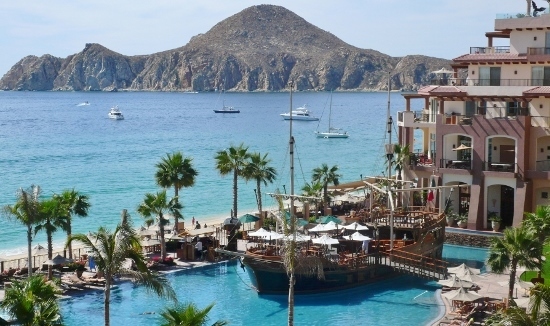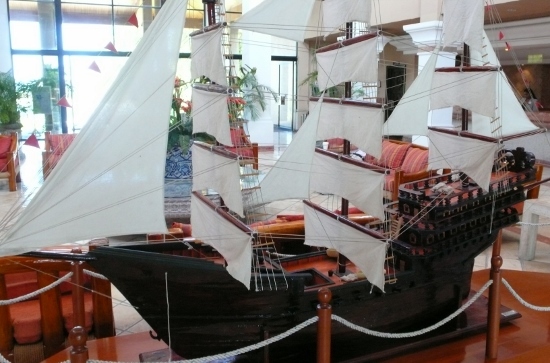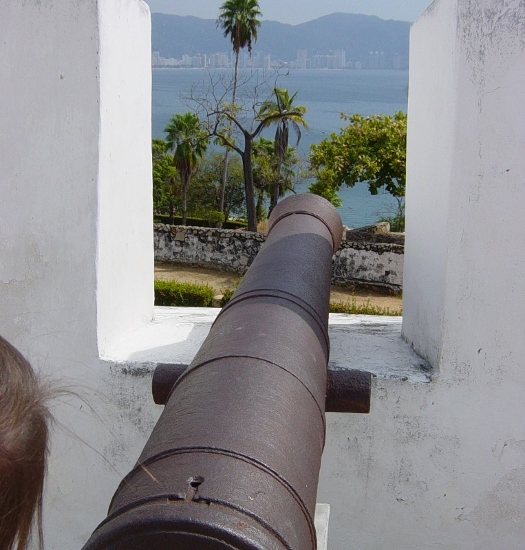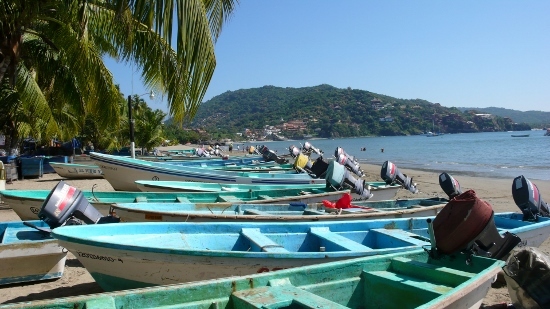Imagine it's the 16th century, and you're on a 2,500-ton Spanish super-galleon sailing off the Pacific coast of Mexico. You're on your way back from a long, dangerous voyage to Manila, where traders from Spain's conquered lands in the Americas swapped silver coins and ingots -- looted from mines across Mexico and Peru -- for silks, porcelain, ivory, spices and the other riches of Asia.
Currents on the return portion of the trip took you to Northern California, after which your ship lumbered down the California coast to the tip of the Baja Peninsula, then skirted the Sea of Cortes to the Mexican mainland.
On the way to your home port at Acapulco are some of the world's most gorgeous bays, at Los Cabos, Mazatlan, Puerto Vallarta, Manzanillo and Zihuatanejo. But your captain casts a nervous eye on these spots -- particularly Zihuatanejo -- because they're known to shelter pirate fleets. And yours is the biggest prize of all.
The story of this ancient, seagoing version of today's jumbo jets goes back to the 1560s, a little over 40 years after the Spanish conquest of Mexico.
East Meets West in Manila
In the Far East, silver rules. Emperors, pashas and shahs dream of filling their palaces with the shiny stuff -- and hundreds of mines on the other side of the Pacific are loaded with it. Meanwhile, the viceroys, marquises and grandees of Mexico yearn to fill their grand haciendas with silks and porcelain from China, and their kitchens with hot munchies from the Spice Islands.
So East and West made a deal to swap their goods. The trading post would be at Manila, a Spanish colony already serving as a commercial link between Europe and Asia. To get there from Mexico, the westerners came up with a new breed of galleons, big enough -- some were nearly as long as a football field -- to carry hundreds of thousands of silver pesos (coins about the size of a U.S. silver dollar) and as many as 1,000 traders, crewmen, soldiers, settlers and convict laborers traveling to the Far East.
The vessels went down in the Spanish history books as the "Naos de China" (ships of China), in the Chinese books as what translated to "the Silver Argosies," and in the English books, "the Manila Galleons."
Their westbound voyages started at Acapulco, Mexico's chief western seaport, where the ships were loaded with silver and supplies for Spain's overseas colonies. They sailed out of the bay under protection of the five gun-studded bastions of Fort San Diego, then latched on to the westerly trade winds to arrive in Manila two to three months later.
It was a lot harder getting back. The ships, now re-loaded with Asian treasures along with returning passengers, sometimes had to sail as far north as Japan and even the Aleutians to find winds and currents heading back across the Pacific. Usually, they ended up off the California coast near Cape Mendocino (170 miles north of modern-day San Francisco). From there, they caught winds blowing off and on down the shores of California, Baja California and western Mexico.
The trip from Manila to Acapulco typically took five or six months, and it was fraught with perils. Not only did the sailors have to worry about storms, tricky currents, starvation, dehydration, scurvy, and rocky, fog-shrouded shorelines, but their exotic cargoes were the prize targets of pirates, privateers (legalized pirates) and wartime enemies of Spain.
No wonder of all the galleons' voyages -- they trekked back and forth across the Pacific singly or in pairs for 250 years until Mexico gained its independence from Spain -- around one out of six trips ended in some kind of disaster.
Prizes for the Jolly Roger
It didn't take a galleon scientist to figure out when the homeward-bound ships would show up off the coast of Mexico. They usually left Acapulco in January or February to take advantage of the season's steady winds to the Philippines. They'd arrive in Manila in late spring, and after a few months of trading would start the homeward voyage around July -- which would normally put them along the Mexican shoreline heading to Acapulco by mid-winter.
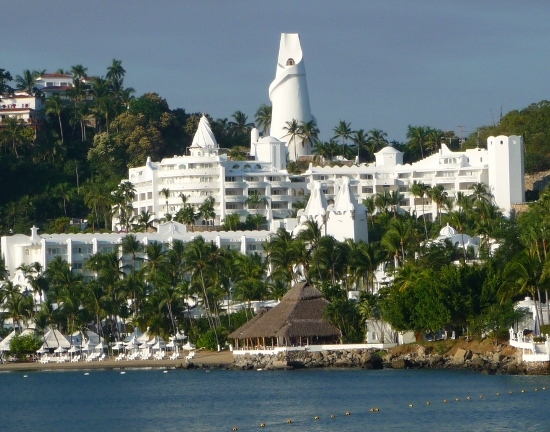
Buccaneers sometimes jumped the ships near the site of Las Brisas' Las Hadas Resort on Manzanillo Bay.
So all the pirates had to do (when they weren't otherwise picking off coastal commerce) was to find a cozy harbor and sit around for a while waiting for the galleons' enormous sails -- marked by the blazing red cross of the Holy Roman Empire -- to pop up on the horizon.
The pirate gauntlet began at the tip of the Baja Peninsula, where the galleons stocked up on fresh water, fruits and vegetables at an eden-like estuary at San Jose del Cabo (now part of the resort complex of Los Cabos) before crossing the Sea of Cortes. While loading up, they were sitting ducks for the scofflaws of the seas.
Those that made it across the Sea of Cortes faced similar attacks along the Mexican mainland when they stopped to replenish their supplies. First up was the bay of Mazatlan, where the swashbucklers could await their prey behind three offshore islands. After that came raids from hidden coves dotting Puerto Vallarta's 60-mile-long Banderas Bay. And a little further down the coast, a good number of galleons were picked off while trying to load up at the two secluded bays at Manzanillo.
At the end of the gauntlet of pirate hideaways was Zihuatanejo. If the galleons could make it past there, the remaining 150 miles to their home port at Acapulco were usually a breeze.
Zihuatanejo's snug, meandering bay, however, was a formidable hurdle. Often lurking there were ships flying the Jolly Roger under the command of notorious raiders of the likes of Sir Francis Drake, William Draper and Thomas Cavendish. What's more, the beaches around the bay were home to many of the pirate crews and their families.
Local historians tell the story of one hapless galleon on its way back from Manila that blundered into the bay -- right into the cannons of a pirate fleet at anchor there. Fine Chinese silks from the ship drifted ashore on a beach, from which it got the name still on the maps today, Playa La Ropa (beach of the clothes).
Rough Seas to Rough Roads
The galleons' grueling voyages across the Pacific were just part of the silks-for-silver odyssey. It began at mines across Mexico, from which raw silver was smeltered into coins and ingots to be carried overland to Acapulco, and at the mega-veins of Peru, from which the coins went by sea to Acapulco.
When the ships returned from Manila full of porcelain, silks, ivory and spices, they were off-loaded at Acapulco where a large share, the so-called King's Fifth (equivalent to a 20 percent tax on the cargo), was earmarked for a 6,000-mile trip to the Royal Court of Spain. Another big portion was divided up between merchants who'd financed the trips. Still other goods "mysteriously disappeared" from the docks to show up for sale elsewhere in Mexico and at Spanish ports all the way down the coast.
The King's Fifth was carried by mule trains and on the backs of Indians over crude roads from Acapulco half-way across the country to Mexico City, and then on to eastern Mexico's main port at Veracruz. From there, treasure fleets took the goods to Spain, starting with a harrowing day or so dodging pirates hiding just outside the bay in the Gulf of Mexico.
A few days later they were in back in pirate-infested waters, this time in the Caribbean for a stop at Spain's outpost in Havana where they joined treasure fleets from Cartagena, Colombia, to form convoys bristling with guns to get them through the northern Caribbean waters. After that, there was one last hurdle: staying afloat and on course during horrendous weather across the Atlantic.
By the time the Asian treasures got to the Royal Court in Spain, much of the goods had traveled two-thirds of the way around the world.
All photos by Bob Schulman.
